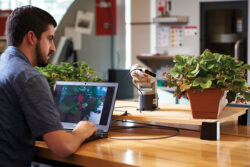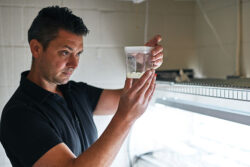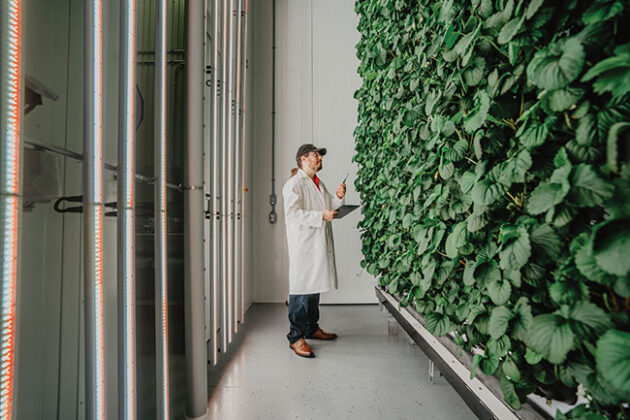
Features
A future ripe with possibility
Eleven teams take up challenge to revolutionize food production in Canada
March 11, 2024 By Weston Family Foundation
 Deborah Henderson, PhD (left) and Li Ma, PhD (right) of Kwantlen Polytechnic University examine a crop of strawberries.
Photo credit: Jay Shaw.
Deborah Henderson, PhD (left) and Li Ma, PhD (right) of Kwantlen Polytechnic University examine a crop of strawberries.
Photo credit: Jay Shaw. “If we listen to plants, we can change the world!” says botanist Lesley Campbell, PhD, describing part of the inspiration behind the raspberry growing system she is developing with her partner, mechanical engineer Habiba Bougherara, PhD, at Toronto Metropolitan University.
Campbell, Bougherara, and their industry partners make up one of eleven teams competing in the Homegrown Innovation Challenge, the Weston Family Foundation’s six-year, $33-million commitment to the next generation of agricultural innovation. These teams include experts and professionals from industries and institutions across the country who are vying to create the most productive, sustainable solutions for growing berries in Canada — out of season and at scale. Supported by grants of up to $1 million for the second phase of the Challenge, the grantees now have eighteen months to develop small-scale, proof-of-concept solutions. If these projects bear fruit—literally—it will be thanks to close collaborations between growers, producers, farmers, engineers, scientists, technologists, and others.
“At the heart of this competition lies the belief that the fusion of collaboration and broad expertise is the key to solving complex challenges in agriculture,” said Garfield Mitchell, Chair of the Weston Family Foundation. “Our grantees bring out-of-the-box, yet achievable, ideas to the table, and we are excited to see the innovations that arise from their shared passion and collaboration.”

Nicholas Varas, Co-founder and CEO Moduleaf Technologies, uses machine learning to monitor plant growth at Ontario Tech University. Photo credit: Kathryn Hollinrake
The Homegrown Innovation Challenge is all about mobilizing Canada’s ecosystem of homegrown talent to play a leading role in the future of food production. The grantees’ solutions must be resilient to a range of Canadian geographies, be at least partially adaptable to other crops, and have a negligible impact on the environment.
“A vertical farm can have tons of air conditioning running almost one hundred per cent of the time,” says Benjamin Feagin Jr., Chief Executive Officer of AgriTech North, which has teamed up with researchers at Collège Boréal. “It frustrates me that technology can bring us in the opposite direction of sustainability.”
Berries were selected as the crops of choice for the competition because of the multiple challenges they present, including short growing seasons, limited shelf life, and vulnerability to pests. These have led to Canada’s outsized reliance on berry imports from distant regions: strawberries alone have annual import values of nearly $475 million.
“Strawberries are so complicated that if we can meet this challenge, we can do a lot of new things,” said Éric Deschambault, President of CycloFields Indoor Farming Technology, which has partnered with an academic team from Université Laval.

Eric Gerbrandt, PhD, Co-Founder and Chief Science Officer, BeriTech Inc.
Photo credit: Michal Urbanek
Some of the projects integrate and enhance existing technologies and practices, while others break new ground. A team from the University of Guelph is combining advanced greenhouses with vertical farming methods originally designed for use in space.
“The solutions that we’ve got for the Moon and Mars are even more suitable for harsh environments here on Earth, especially Canada and Canada’s North in particular,” says project leader Mike Dixon, Director of Guelph’s Controlled Environment Systems Research Facility.
Other strategies include using photovoltaics panels to convert solar energy into electricity, biosensors for monitoring plant health in real time, and artificial intelligence capable of adjusting growing conditions every few minutes. One project aims to produce compact blueberry plants with more fruit buds through gene editing, while another looks at the potential for sculpting microbiomes.
Economic opportunity and sustainable livelihoods for farmers are top of mind for all grantees.
“Traditional farming will always have a place because farmers are most in touch with the land,” says Osman Hamid, PhD, Director of Creativity and Entrepreneurship at Brilliant Catalyst, Ontario Tech University’s innovation hub. “But technology can make farmers more competitive.”
These agtech solutions may also ease the demanding labour that drives many families from their farms and deters others from a life in agriculture. A recent report from RBC estimates that approximately 40 per cent of Canadian farmers will retire within the next decade, and about 66 per cent don’t have a succession plan. The report also predicts a shortfall of 24,000 general farm, nursery, and greenhouse workers.
“This was part of my life, and I couldn’t see a way I could participate,” said Lesley Campbell, remembering the heartbreaking decision to let her family cabbage farm go after her father retired. “We need to humanize this. Even though we’re industrializing agriculture, there are still farm families behind it.”
Making a place on the farm for engineers, scientists, and academics is the first step towards supporting the future generations of growers who will safeguard the country’s food production, along with investments in training and educational opportunities.
“We don’t want to take growers’ jobs away,” says Doan Ha, Director of Operations at Koidra, an intelligent automation company that’s collaborating with researchers from the University of Guelph’s School of Environmental Sciences and Agriculture and Agri-Food Canada.
“We want to make humans superhuman by using our software as a tool kit that takes away repetitive tasks, so growers can focus on high-level work and see higher profitability.”

Christian Desjardins, Mechanical Design and Manufacturing for CycloFields Indoor Farming Technology. Université Laval and Cyclofields are working together to pioneer an integrated aeroponic strawberry production system for year-round harvests.
Photo credit: Dany Vachon
Grantee spotlight:
Future-proofing greenhouses for the next generation
Researchers at Kwantlen Polytechnic University are working on an advanced greenhouse system that relies on AI-driven robots to reduce both the cost of, and use of pesticides in, the production of strawberries and blackberries. State-of-the-art technology like lasers and other advanced optical sensors will also be heavily used to manage disease and treat biostimulants.
“As farm agriculture gets more technical, it is attracting the younger people,” said Deborah Henderson, PhD, Kwantlen Polytechnic University.
“I work at a university where I’m privileged to see the determination of young people and the innovations that walk into my office. It gives me hope.”
Variety is the spice of life, and it may also be the secret to year-round blueberry production
Like many crops, blueberry plants are highly sensitive to environmental conditions. Simon Fraser University and BeriTech Inc. are teaming up to apply advanced and proprietary approaches to create the perfect growing conditions for this sensitive crop. Their plant-centric approach focuses on selecting blueberry varieties that are best suited to indoor growing and tailoring environmental conditions to drive optimal fruit yields and quality.
“We have to start with the plant, and then we can tailor environmental conditions to what the plant needs. We can perfect conditions to take full advantage of the plant’s genetic potential. Eric Gerbrandt, PhD, Managing Partner, BeriTech Inc.
Building an ecosystem where both plants and innovation will thrive
At Ontario Tech University, a team is developing an energy-efficient controlled-environment agriculture facility that will outperform traditional greenhouses in the production of strawberries—particularly during the winter months in Canada. They will be equipped with an Autonomous Intelligent Monitoring System to monitor health and growth, which will trigger early interventions if plants start to wane.
“The next generation doesn’t see new technology as a threat. They see it as a way to further their legacies. That is the exciting part, being able to work with new partners and grow our networks.” Alex McKay, co-owner of Willowtree Farm and a member of the Ontario Tech HGC team.
Print this page